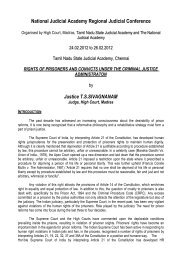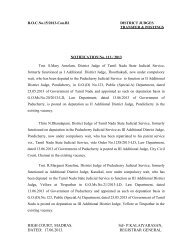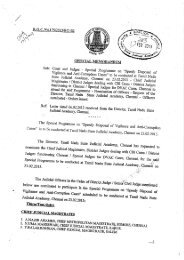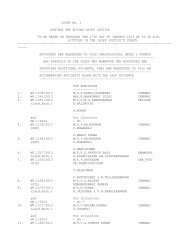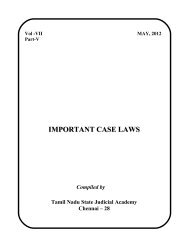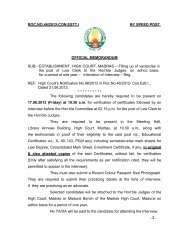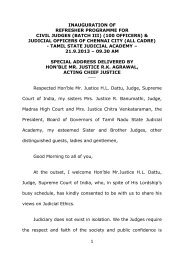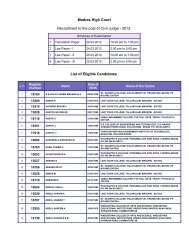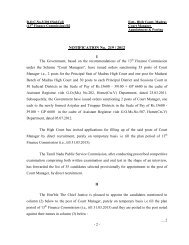Appreciation of Evidence in Sessions Cases - Justice D.Murugesan
Appreciation of Evidence in Sessions Cases - Justice D.Murugesan
Appreciation of Evidence in Sessions Cases - Justice D.Murugesan
You also want an ePaper? Increase the reach of your titles
YUMPU automatically turns print PDFs into web optimized ePapers that Google loves.
Section 32 – Multiple dy<strong>in</strong>g declarations – Reliability – Accused was named <strong>in</strong> all dy<strong>in</strong>g declarations<br />
as per who poured kerosene on deceased and set him on fire – Dy<strong>in</strong>g Declarations though more than one<br />
not contradictory to and <strong>in</strong>consistent with each other – <strong>Evidence</strong> <strong>of</strong> witnesses corroborat<strong>in</strong>g dy<strong>in</strong>g<br />
declarations – reliance can be placed on such dy<strong>in</strong>g declarations – Vimal vs. State <strong>of</strong> Maharashtra -<br />
2006 AIR SCW 5953.<br />
Section 32 – Dy<strong>in</strong>g Declaration – Conviction can <strong>in</strong>disputably be based on a dy<strong>in</strong>g declaration but<br />
before it cannot be acted upon, the same held to have been rendered voluntarily and truthfully –<br />
Consistency <strong>in</strong> the dy<strong>in</strong>g declaration is the relevant factor for plac<strong>in</strong>g full reliance thereupon –<br />
Mehiboobsab Abbasafi Nadaf vs. State <strong>of</strong> Karnataka – 2007 (5) Supreme 713.<br />
The Hon’ble Apex Court <strong>in</strong> Samadhan Dhudka Koli V. State <strong>of</strong> Maharashtra reported <strong>in</strong> 2008 (8)<br />
Supreme 719 has held that,<br />
“16. Consistency <strong>in</strong> the dy<strong>in</strong>g declaration, therefore, is a very relevant factor. Such a relevant factor<br />
cannot be ignored. When a contradictory and <strong>in</strong>consistent stand is taken by the deceased herself<br />
<strong>in</strong> different dy<strong>in</strong>g declarations, they should not be accepted on their face value. In any event, as a<br />
rule <strong>of</strong> prudence, corroboration must be sought from other evidence brought on record.”<br />
1) DASHRATH @ CHAMPA & OTHERS Vs.. STATE OF MADHYA PRADESH [CDJ 2007<br />
SUPREME COURT 1161] : [JT 2007 (12) SC 400]<br />
Indian <strong>Evidence</strong> Act, 1872 – Section 32 – Dy<strong>in</strong>g Declaration.<br />
Para 12. Though a dy<strong>in</strong>g declaration is entitled to great weight, it is worthwhile to note that the<br />
accused has no scope <strong>of</strong> cross-exam<strong>in</strong>ation. Such a scope is essential for elicit<strong>in</strong>g the truth as an<br />
obligation <strong>of</strong> oath could be. This is the reason the Court also <strong>in</strong>sists that the dy<strong>in</strong>g declaration should be <strong>of</strong><br />
such a nature as to <strong>in</strong>spire full confidence <strong>of</strong> the Court <strong>in</strong> its correctness. The Court has to be on guard that<br />
the statement <strong>of</strong> deceased was not as a result <strong>of</strong> either tutor<strong>in</strong>g, or prompt<strong>in</strong>g or a product <strong>of</strong> imag<strong>in</strong>ation.<br />
The Court must be further satisfied that the deceased was <strong>in</strong> a fit state <strong>of</strong> m<strong>in</strong>d after a clear opportunity to<br />
observe and identify the assailant. Once the Court is satisfied that the declaration was true and voluntary,<br />
undoubtedly, it can base its conviction without any further corroboration. It cannot be laid down as an<br />
absolute rule <strong>of</strong> law that the dy<strong>in</strong>g declaration cannot form the sold basis <strong>of</strong> conviction unless it is<br />
corroborated. The rule requir<strong>in</strong>g corroboration is merely a rule <strong>of</strong> prudence. This Court has laid down <strong>in</strong><br />
several judgments the pr<strong>in</strong>ciples govern<strong>in</strong>g dy<strong>in</strong>g declaration, which could be summed up as under as<br />
<strong>in</strong>dicated <strong>in</strong> Smt. Paniben v. State <strong>of</strong> Gujarat (AIR 1992 SC 1817):<br />
(i) There is neither rule <strong>of</strong> law nor <strong>of</strong> prudence that dy<strong>in</strong>g declaration cannot be acted upon<br />
without corroboration. [See Munnu Raja & Anr. V. The state <strong>of</strong> Madhya Pradesh (1976) 2<br />
SCR 764]<br />
(ii) If the Court is satisfied that the dy<strong>in</strong>g declaration is true and voluntary it can base<br />
conviction on it, without corroboration. [See State <strong>of</strong> Uttar Pradesh V. Ram Sagar Yadav<br />
and Ors. (AIR 1985 SC 416) and Ramavati Devi v. State <strong>of</strong> Bihar (AIR 1983 SC 164) ]<br />
(iii) The Court has to scrut<strong>in</strong>ize the dy<strong>in</strong>g declaration carefully and must ensure that the<br />
declaration is not the result <strong>of</strong> tutor<strong>in</strong>g, prompt<strong>in</strong>g or imag<strong>in</strong>ation. The deceased had an<br />
opportunity to observe and identify the assailants and was <strong>in</strong> a fit state to make the<br />
23



